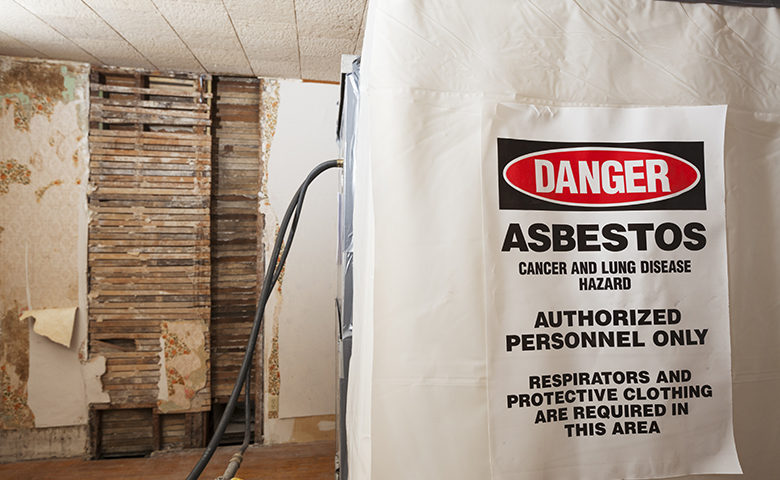Asbestos is a harmful material that was once heavily used in a number of industries. For decades it caused exposure in workers and many people got sick with mesothelioma, lung cancer, and other respiratory issues.
Now, asbestos use is regulated but you may still encounter it on the job. It’s important to know the safety procedures for encountering asbestos and how to educate workers on what to do if they run into asbestos on the job.
What is asbestos?
Asbestos is a group of fibrous minerals and a known human carcinogen. It resists heat, corrosion, fire, and electricity. It is lightweight, flexible, and strong. With these properties, asbestos has been useful in a variety of workplace applications. It has been used in construction materials, especially insulation, automotive brakes and clutches, and many materials on board ships.
There are a few industries and workplaces in which you are most likely to encounter asbestos and be at the biggest risk for heavy exposure. These include construction sites, shipbuilding and repair, and automotive repair. The possibility of exposure is greatest for workers removing asbestos or doing maintenance, renovation, or demolition jobs.
What are the risks of asbestos exposure?
Exposure to asbestos is dangerous because the small fibers that can be disturbed by workplace practices may be inhaled or ingested and later cause serious illness. Undisturbed asbestos doesn’t pose much of a risk, but when the fibers come loose from materials they can be harmful.
Inhalation or ingestion of the fibers can cause tissue damage. In some people who experience exposure, the damage leads to lung cancer, pleural or peritoneal mesothelioma, or asbestosis, a lung-scarring disease. The heavier and longer duration of the exposure, the bigger the risk is of getting sick later.
Know where to find asbestos
Workers in industries where asbestos can be found should be aware of where it may be located and how to identify it. Jobs in which workers should be particularly aware include:
- any renovation or demolition in buildings constructed before 1981;
- automotive workers repairing or replacing clutches and brakes;
- any renovation, repair, or demolition of ships built before 1981;
- workers cleaning up in any of the above locations or job sites; and
- rescue workers and cleaning crews around buildings hit by natural disasters.
Look for asbestos in many building and ship construction materials, especially vinyl flooring and adhesives, roofing tiles, siding, thermal insulation, pipe wrapping, cement and plaster, spray-on coatings, ceiling tiles, putty and caulk, fire-proofing materials, and heat-resistant textiles.
What to do if you find or suspect asbestos on a work site
If you think there is asbestos in your work area, you should inform company management or the asbestos program manager (APM). In jobs that may require workers to be around asbestos, there should be an APM and an asbestos management policy. If you’re concerned that the asbestos you see poses a risk, or if it looks like it is disturbed and could be shedding fibers, workers have a right to stop working until given appropriate safety gear and training in how to use it.
To work safely around asbestos, people must be supplied with protective clothing that has to be removed before leaving the job site to avoid carrying away fibers. Workers should also be given access to a respirator to prevent inhalation. Your superior or APM can tell you if you need to use safe asbestos work practices, such as wetting the asbestos materials and using a HEPA vacuum.
You should also be aware of your company’s procedure in the event that there is an exposure incident. For instance, if a wall collapses and disturbs and spreads asbestos fibers, there should be a procedure in place to prevent or minimize exposure. This may include isolating the area, alerting others nearby, and safely cleaning and inspecting the area.
Worker rights
Under federal law, workers have a right to a safe work environment, which includes being kept safe from the hazards of asbestos. According to OSHA, workers have a right to:
- be trained and have information about environmental hazards in the workplace;
- have access to past incidents of work-related injuries and illnesses;
- test results for workplace hazards; and
- file a complaint if they believe the workplace needs to be inspected or the employer isn’t following OSHA guidelines.
Employees also have the right to exercise all these rights without discrimination and without the fear of retaliation by other workers or their employer.
Asbestos exposure can cause serious harm, and safety managers and supervisors must minimize the risk of exposure and respect workers’ rights to a safe work environment. Know their rights (and yours too), understand your employer’s procedures and asbestos safety plans, and be sure that everyone has access to the appropriate training and safety gear.

